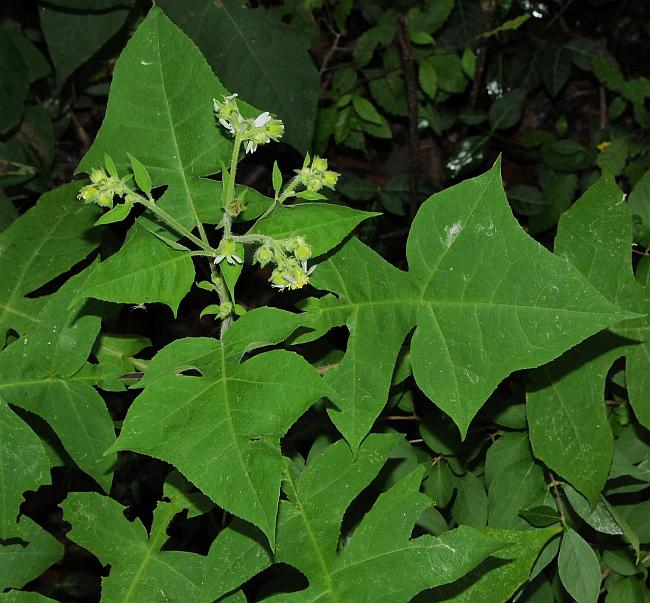Polymnia canadensis L.
Pale-Flowered Leaf Cup

Native
CC = 6
CW = 5
MOC = 43
© SRTurner
Polymnia canadensis L.Pale-Flowered Leaf Cup | |
 |
Native CC = 6 CW = 5 MOC = 43 |
© SRTurner |
|
Family - Asteraceae/Heliantheae Habit - Perennial forb, usually rhizomatous and colonial. Herbage with a characteristic odor when bruised. Stems - Ascending to erect, to 1.8 m, multiple from base, moderately to densely pubescent with mostly gland-tipped or sticky hairs toward the tip, glabrous or nearly so toward the base.
Leaves - Opposite, petiolate, stipulate. Petioles to 10 cm long, glandular puberulent, green to purplish near base. Blade tissue often decurrent on petiole for a short distance, or blade with two additional small lobes at base. Larger leaves often with rounded appendages of green tissue at the petiole base, these wrapping around the stem, the appendages of the adjacent leaves at a given node sometimes fused into a short cup around the stem. Leaf blades 3-40 cm long, mostly broadly tapered at the base, mostly with 3-7 more or less pinnate lobes (the smaller, upper leaves sometimes unlobed), the lobes tapered to a sharply pointed tip, the margins otherwise finely to coarsely toothed, the surfaces glabrous or sparsely to moderately pubescent with spreading, sometimes sticky or gland-tipped hairs, especially along the veins. Uppermost leaves undivided, ovate.
Inflorescence - Loose, irregular terminal clusters of flower heads, these often spreading to nodding. Inflorescence divisions subtended by reduced foliaceous bracts. Branches of inflorescence densely viscid glandular pubescent.
Heads - Radiate but sometimes appearing discoid. Involucre 5-9 mm long, 6-13 mm in diameter, the bracts in two dissimilar series, moderately to densely pubescent with sticky or gland-tipped hairs on the outer surface. Outer series of 2-4 involucral bracts somewhat longer and narrower than the others, lanceolate to narrowly ovate, the inner series ovate to broadly obovate. Receptacle flat or slightly convex, the chaffy bracts thin and papery, concave and wrapped around the florets.
Flowers - Ray florets usually 5, pistillate, the corolla reduced to a minute tube and lacking a ligule or with a short, broad ligule 2-10 mm long, 3 lobed at apex, densely pubescent, white. Disc florets 26-40, staminate, the corolla 3-4 mm long, pale yellow, the apex expanded, 5-lobed, often glandular. Pappus absent.
Fruits - Achenes with 3 blunt angles or less commonly ribs, dark brown to black, usually with some reddish brown mottling, those of the ray florets larger than those of the disk florets. Flowering - May - October. Habitat - Forests, ravines, bases and ledges of bluffs, streambanks, fencerows, pastures, railroads, and roadsides. Often associated with limestone substrate. Origin - Native to the U.S. Other info. - This species is found in Missouri mostly in the southeastern half of the state, though it is apparently absent from the Bootheel region. Beyond Missouri its range extends in somewhat scattered fashion within the upper U.S. Midwest and toward New England. The plant is recognized by its large, lobed leaves and relatively non-showy flowering heads with white rays (these sometimes appearing absent). The upper stems and leaves typically have a clammy or mildly sticky feel due to their glandularity, and bruised foliage emits an odor which is difficult to describe but highly characteristic. The plant has a particular affinity for bases of rocky slopes or bluffs. Look closely at the disk flowers and you will notice that the styles are undivided, which is an indication that they are sterile. The ray florets have divided styles, indicating that they are pistillate. This difference in functionality is always something to look for when trying to identify plants in the Asteraceae. Photographs taken in the Ozark Scenic Riverways, 5-27 and 6-3-03 (DETenaglia); also along the Katy Trail near the Boone Bridge, St. Charles County, MO, 8-13-2014 (SRTurner). |